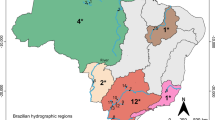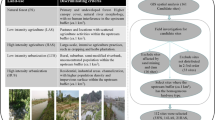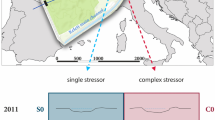Abstract
Disturbances caused by both natural and anthropogenic forces can drive changes in alpha and beta taxonomic diversity and be accompanied by losses or gains in freshwater ecosystem function (e.g., secondary productivity and rate of decomposition). In this study, we tested the hypothesis that increases in cladoceran (microcrustaceans) taxonomic beta diversity in highly impacted environments lead to functional simplification and homogenization of community trait composition. This was accomplished by comparing a reference group of low-impact waterbodies (lakes and reservoirs) to high-impact waterbodies located in four regions of northeastern and south Brazil. Functional composition of cladoceran communities was inferred using a suite of morphological, physiological, behavioral, and life-history traits. Differences in taxonomic and functional community composition were tested using univariate and multivariate statistics. Taxonomic beta diversity and functional richness differed significantly between the reference (low-impact) and high-impact waterbodies, where high-impact environments showed higher taxonomic and functional beta diversity and lower functional richness. By contrast, we found functional homogenization of cladoceran communities in just one out of the four regions. Last, we propose that disturbances can affect traits locally in communities, making them rarer until they are lost, by promoting functional simplification. When disturbances are persistent, they lead to functional and taxonomic homogenization.




Similar content being viewed by others
References
Abonyi, A., Z. Horváth & R. Ptacnik, 2018. Functional richness outperforms taxonomic richness in predicting ecosystem functioning in natural phytoplankton communities. Freshwater Biology 63: 178–186.
Allan, J., 1976. Life history patterns in zooplankton. American Naturalist 110: 165–180.
Anderson, M. J., K. E. Ellingsen & B. H. McArdle, 2006. Multivariate dispersion as a measure of beta diversity. Ecology Letters 9: 683–693.
Aspin, T. W. H., T. J. Matthews, K. Khamis, A. M. Milner, Z. Wang, M. J. O’Callaghan & M. E. Ledger, 2018. Drought intensification drives turnover of structure and function in stream invertebrate communities. Ecography 41: 1992–2004.
Barnett, A. J., K. Finlay & B. E. Beisner, 2007. Functional diversity of crustacean zooplankton communities: towards a trait-based classification. Freshwater Biology 52: 796–813.
Bishop, T. R., M. P. Robertson, B. J. van Rensburg & C. L. Parr, 2015. Contrasting species and functional beta diversity in montane ant assemblages. Journal of Biogeography 42: 1776–1786.
Biswas, S. R. & A. U. Mallik, 2010. Disturbance effects on species diversity and functional diversity in Riparian and Upland Plant Communities. Ecology 91: 28–35.
Bonecker, C. C., N. R. Simões, C. V. Minte-Vera, F. A. Lansac-Tôha, L. F. M. Velho & A. A. Agostinho, 2013. Temporal changes in zooplankton species diversity in response to environmental changes in an alluvial valley. Limnologica - Ecology and Management of Inland Waters 43: 114–121.
Bovo-Scomparin, V., S. Train & L. Rodrigues, 2013. Influence of reservoirs on phytoplankton dispersion and functional traits: a case study in the Upper Paraná River, Brazil. Hydrobiologia 702: 115–127.
Braghin, L. S. M., B. A. Almeida, D. C. Amaral, T. F. Canella, B. C. G. Gimenez & C. C. Bonecker, 2018. Effects of dams decrease zooplankton functional β-diversity in river-associated lakes. Freshwater Biology 63: 721–730.
Clavel, J., R. Julliard & V. Devictor, 2011. Worldwide decline of specialist species: toward a global functional homogenization? Frontiers in Ecology and the Environment 9: 222–228.
Díaz, S. & M. Cabido, 2001. Vive la différence: plant functional diversity matters to ecosystem processes. Trends in Ecology and Evolution. 12: 646–655.
Dirzo, R., H. S. Young, M. Galetti, G. Ceballos, N. J. B. Isaac & B. Collen, 2014. Defaunation in the Anthropocene. Science 345: 401–406.
Dunck, B., S. A. Felisberto & I. de Souza Nogueira, 2019. Effects of freshwater eutrophication on species and functional beta diversity of periphytic algae. Hydrobiologia 837: 195–204.
Edmondson, W. T. & G. C. Winberg, 1971. A manual on methods for the assessment of secondary productivity in freshwaters. Blackwell, Oxford.
Eggermont, H. & K. Martens, 2011. Preface: Cladocera crustaceans: sentinels of environmental change. Hydrobiologia 676: 1–7.
Elmoor-Loureiro, L., 1997. Manual de Identificação de cladóceros Limnicos do Brasil. Editora Universa. Universa, Brasilia.
Fischer, J. M., T. M. Frost & A. R. Ives, 2001. Compensatory dynamics in zooplankton community responses to acidification: measurement and mechanisms. Ecological Application 11: 1060–1072.
Forró, L., N. Korovchinsky, A. Kotov & A. Petrusek, 2008. Global diversity of cladocerans (Cladocera; Crustacea) in freshwater. Hydrobiologia 595: 177–184.
Hawkins, C. P., H. Mykrä, J. Oksanen & J. J. Vander Laan, 2015. Environmental disturbance can increase beta diversity of stream macroinvertebrate assemblages. Global Ecology and Biogeography 24: 483–494.
Hooper, D. U., F. S. Chapin III, J. J. Ewel, A. Hector, P. Inchausti, S. Lavorel, J. H. Lawton, D. M. Lodge, M. Loreau, S. Naeem, B. Schimid, H. Setala, A. Symstad, J. Vamdermeer & D. Wardle, 2005. Effects of biodiversity on ecosystem functioning: a consensus of current knowledge. Ecological Monographs 75: 3–35.
Hutchinson, G. E., 1957. Concluding Remarks. Population studies: animal ecology and demography 22: 415–427.
Iserhard, C. A., L. Duarte, N. Serafim & A. V. L. Freitas, 2019. How urbanization affects multiple dimensions of biodiversity in tropical butterfly assemblages. Biodiversity and Conservation 28: 621–638.
Julio Jr., H. F., S. M. Thomaz & A. A. Agostinho, 2005. Distribuição e caracterização dos reservatórios. In Rodrigues, L., S. M. Thomaz, A. A. Agostinho & J. D. Latini (eds), Biocenoses em Reservatórios. Padrões Espaciais e Temporais, Rima: 1–16.
Junk, W. J., P. B. Bayley & R. E. Sparks, 1989. The flood pulse concept in river-floodplain systems. Canadian Special Publication of Fisheries and Aquatic Sciences 106: 110–127.
McKinney, M. L. & J. L. Lockwood, 1999. Biotic homogenization: a few winners replacing many losers in the next mass extinction. Trends in Ecology & Evolution 14: 450–453.
Lansac-Tôha, F. A., C. C. Bonecker, L. F. M. Velho, N. R. Simões, J. D. Dias, G. M. Alves & E. M. Takahashi, 2009. Biodiversity of zooplankton communities in the Upper Paraná River floodplain: interannual variation from long-term studies. Brazilian Journal of Biology 69: 539–549.
Legendre, P. & L. Legendre, 1998. Numerical Ecology. Elsevier Science Ltd.
Litchman, E., M. D. Ohman & T. Kiørboe, 2013. Trait-based approaches to zooplankton communities. Journal of Plankton Research 35: 473–484.
Mouillot, D., N. A. J. Graham, S. Villéger, N. W. H. Mason & D. R. Bellwood, 2013. A functional approach reveals community responses to disturbances. Trends in Ecology and Evolution 28: 167–177.
Mykrä, H., M. Tolkkinen & J. Heino, 2017. Environmental degradation results in contrasting changes in the assembly processes of stream bacterial and fungal communities. Oikos 126: 1291–1298.
Neiff, J., 1990. Ideas para la interpretación ecológica del Paraná. Interciencia 15: 424–441.
O’Connor, N. E. & T. P. Crowe, 2005. Biodiversity loss and ecosystem functioning: distinguishing between number and identity of species. Ecology 86: 1783–1796.
Oliveira, A. G., M. T. Baumgartner, L. C. Gomes, R. M. Dias & A. A. Agostinho, 2018. Long-term effects of flow regulation by dams simplify fish functional diversity. Freshwater Biology 63: 293–305.
Pagioro, T. A., S. M. Thomaz & M. C. Roberto, 2005. Caracterização limnológica abiótica de reservatórios. In Rodrigues, L., S. M. Thomaz, A. A. Agostinho & J. D. Latini (eds), Biocenoses em Reservatórios. Padrões Espaciais e Temporais, Rima: 17–37.
Pennak, R. W., 1989. Fresh-water Invertebrates of the United States: protozoa to Mollusca. 628 p. Wiley Interscience Publication, New York.
Pimm, S. L., 1984. The complexity and stability of ecosystems. Nature 307: 321–326.
R Development Core Team, 2015. R: a Language and Environment for Statistical Computing. R Foundation for Statistical Computing, Viena.
Rizo, E. Z. C., Y. Gu, R. D. S. Papa, H. J. Dumont & B. P. Han, 2017. Identifying functional groups and ecological roles of tropical and subtropical freshwater Cladocera in Asia. Hydrobiologia 799: 83–99.
Rocha, P. C., 2010. Indicators of hydrologic alteration in the High Parana River catchment: human interventions and implications for dynamic of the fluvial environment. Sociedade & Natureza. 22: 191–211.
Santos, R. E., R. M. Pinto-Coelho, R. Fonseca, N. R. Simões & F. B. Zanchi, 2018a. The decline of fisheries on the Madeira River, Brazil: the high cost of the hydroelectric dams in the Amazon Basin. Fisheries Management and Ecology 25: 380–391.
Santos, J. S., N. R. Simões & S. L. Sonoda, 2018b. Spatial distribution and temporal variation of microcrustaceans assembly (Cladocera and Copepoda) in different compartments of a reservoir in the brazilian semiarid region. Acta Limnologica Brasiliensia. https://doi.org/10.1590/s2179-975x9616.
Simões, N. R., F. A. Lansac-Tôha & C. C. Bonecker, 2013. Drought disturbances increase temporal variability of zooplankton community structure in floodplains. International Review of Hydrobiology 98: 24–33.
Simões, N. R., A. H. Nunes, J. D. Dias, F. A. Lansac-Tôha, L. F. M. Velho & C. C. Bonecker, 2015. Impact of reservoirs on zooplankton diversity and implications for the conservation of natural aquatic environments. Hydrobiologia 758: 3–17.
Simões, N. R. & S. L. Sonoda, 2009. Estrutura da assembléia de microcrustáceos (Cladocera e Copepoda) em um reservatório do semi-árido Neotropical, Barragem de Pedra, Estado da Bahia, Brasil. Acta Scientiarum. Biological Sciences 31: 89–95.
Socolar, J. B., J. J. Gilroy, W. E. Kunin & D. P. Edwards, 2016. How should beta-diversity inform biodiversity conservation? Trends in Ecology and Evolution 31: 67–80.
Sodré, O. D. & R. L. Bozelli, 2019. How planktonic microcrustaceans respond to environment and affect ecosystem: a functional trait perspective. International Aquatic Resarch 11: 207–223.
Tundisi, J. G., 1999. Reservatórios Como Sistemas Complexos. In Henry, R. (ed), Ecologia de Reservatórios. Fundbio/Fapesp, São Paulo: 19–38.
Uys, R. G., W. J. Bond & T. M. Everson, 2004. The effect of different fire regimes on plant diversity in southern African grasslands. Biological Conservation 118: 489–499.
Villéger, S., G. Grenouillet & S. Brosse, 2013. Decomposing functional β-diversity reveals that low functional β-diversity is driven by low functional turnover in European fish assemblages. Global Ecology and Biogeography 22: 671–681.
Villéger, S., N. W. H. Mason & D. Mouillot, 2008. New multidimensional functional diversity indices for a multifaceted framework in functional ecology. Ecology 89: 2290–2301.
Vinebrooke, R. D., K. L. Cottingham, M. J. Scheffer, S. I. Dodson, S. C. Maberly & U. Sommer, 2004. Impacts of multiple stressors on biodiversity and ecosystem functioning: the role of species co-tolerance. Oikos 104: 451–457.
Violle, C., E. Garnier, M.-L. Navas, C. Fortunel, D. Vile, E. Kazakou & I. Hummel, 2007. Let the concept of trait be functional! Oikos 116: 882–892.
Winberg, G. C., G. A. Pechen & E. A. Shusshkina, 1965. Production of planktonic crustaceans in three lakes of different type. Zoologichesky Zhurnal 44: 676–687.
Zar, J., 2010. Bioestatistical Analysis. Prentice Hall, Upper Saddle River.
Acknowledgements
Coordination for the Improvement of Higher Education Personnel (CAPES) by scholarships of GAVD and LSMB. CAPES, Nupélia, PELD/CNpq (site 6-PIAP), FAPESB, Proex/CAPES for logistic and financial support. CCB receives grants from the Brazilian National Council of Research and Development (CNPq). We thank the two anonymous reviewers and Julian Olden who substantially contributed to the improvement of the manuscript.
Author information
Authors and Affiliations
Corresponding author
Additional information
Publisher's Note
Springer Nature remains neutral with regard to jurisdictional claims in published maps and institutional affiliations.
Guest editors: André A. Padial, Julian D. Olden & Jean R. S. Vitule / The Aquatic Homogenocene
Electronic supplementary material
Below is the link to the electronic supplementary material.
Rights and permissions
About this article
Cite this article
Simões, N.R., Braghin, L.S.M., Duré, G.A.V. et al. Changing taxonomic and functional β-diversity of cladoceran communities in Northeastern and South Brazil. Hydrobiologia 847, 3845–3856 (2020). https://doi.org/10.1007/s10750-020-04234-w
Received:
Revised:
Accepted:
Published:
Issue Date:
DOI: https://doi.org/10.1007/s10750-020-04234-w




